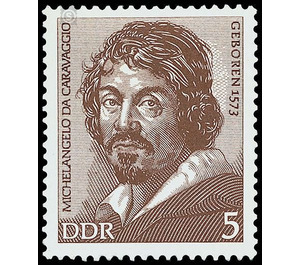Commemorative stamp series - Germany / German Democratic Republic 1973 - 5 Pfennig
Theme: Calender
| Country | Germany / German Democratic Republic |
| Issue Date | 1973 |
| Face Value | 5.00 |
| Color | brown |
| Perforation | K 13 1/2: 13 |
| Printing Type | offset |
| Stamp Type | Postage stamp |
| Item Type | Stamp |
| Chronological Issue Number | 1557 |
| Chronological Chapter | GER-DDR |
| SID | 488902 |
| In 11 Wishlists | |
Significant personalities, 1973 edition The Ministry of Posts and Telecommunications of the German Democratic Republic publishes five special postage stamps with illustrations of important personalities. No special first day cover Important figures 5-pfennig value MICHELANGELO DA CARAVAGGIO (aka Meresi, also Amerighi), born on September 28, 1573 in Caravaggio near Bergamo, is considered the most important master of the realistic early Baroque. The Italian painter revolutionized the way of seeing and shaping the visual arts of his time, influencing the great masters of 17th-century European painting such as Rubens, Rembrandt and Velasques. There is a good reason why bourgeois art science decries him as a "naturalist and cellar-painter," for Caravaggio was the first and most important Italian painter to place his people on the streets of Rome, Naples, and Milan on the rice fields of southern Italy Works ("The Fortune Teller", "The Lute Player", "The Card Players"). Even in images with religious motifs such as "Matheus with the Angel", "Rest on the Run", "Holy Magdalene", "Entombment", the mythological figures have realistic features, they are people of flesh and blood. Above all, the subjects are Caravaggio's full of passionate, dramatic action, lifelike and real. The technique of the sharp contrasts of light and dark, especially invented by Caravaggio in his late works, makes his figures and their postures very lively, tangible. His popular, realistic style of painting soon provoked rejection and persecution by Caravaggio's rich clients, while the clergy banished the painter's works from churches and patrician homes. The short life of the painter was as passionate and dramatic as his works. Having emerged from the Manirist school, he moved to Rome after a radical break with his teachers, quickly became famous for his genre paintings and still lifes; involved in Handel and legal conflicts, he finally had to flee the city for manslaughter. Now he wandered restlessly through southern Italy, with short stays in Milan, Naples and Malta. Arrested and fled several times, he was attacked on the way back to Rome and died of his wounds on July 18, 1610 in Porto d'Ercole, barely 37 years old.


